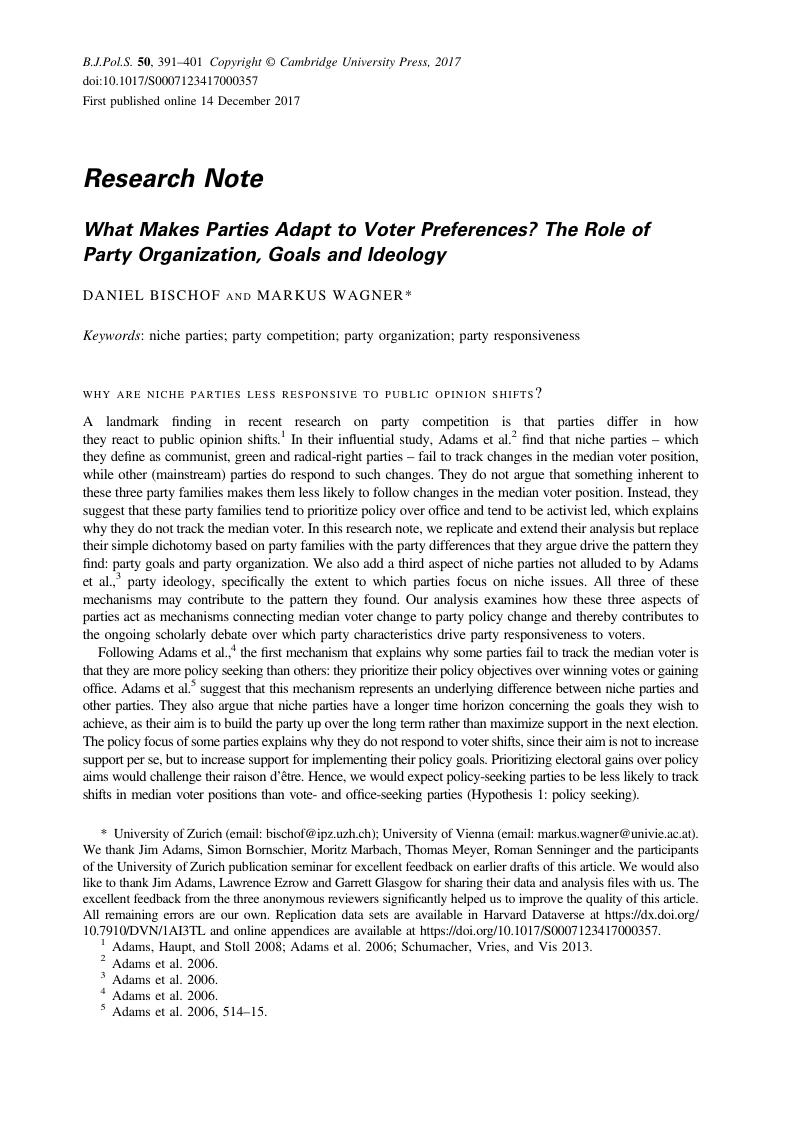Crossref Citations
This article has been cited by the following publications. This list is generated based on data provided by
Crossref.
BISCHOF, DANIEL
and
SENNINGER, ROMAN
2018.
Simple politics for the people? Complexity in campaign messages and political knowledge.
European Journal of Political Research,
Vol. 57,
Issue. 2,
p.
473.
Kernecker, Theresa
and
Wagner, Markus
2019.
Niche parties in Latin America.
Journal of Elections, Public Opinion and Parties,
Vol. 29,
Issue. 1,
p.
102.
Blings, Steffen
2020.
Niche Parties and Social Movements: Mechanisms of Programmatic Alignment and Party Success.
Government and Opposition,
Vol. 55,
Issue. 2,
p.
220.
Peña, Alejandro M
2021.
Activist Parties and Hybrid Party Behaviours: A Typological Reassessment of Partisan Mobilisation.
Political Studies Review,
Vol. 19,
Issue. 4,
p.
637.
Medeiros, Mike
Gauvin, Jean-Philippe
and
Chhim, Chris
2022.
Unified voters in a divided society: Ideology and regionalism in Belgium.
Regional & Federal Studies,
Vol. 32,
Issue. 1,
p.
53.
Røed, Maiken
2022.
Party goals and interest group influence on parties.
West European Politics,
Vol. 45,
Issue. 5,
p.
953.
ENNSER‐JEDENASTIK, LAURENZ
HASELMAYER, MARTIN
HUBER, LENA MARIA
and
FENZ, MARTIN
2022.
Who talks about what? Issue strategies across the party hierarchy.
European Journal of Political Research,
Vol. 61,
Issue. 3,
p.
842.
Rodi, Michael
2022.
Economic Analysis of Public Law.
p.
59.
Wenzelburger, Georg
2022.
Handbuch Policy-Forschung.
p.
1.
Ibenskas, Raimondas
and
Polk, Jonathan
2022.
Party Responsiveness to Public Opinion in Young Democracies.
Political Studies,
Vol. 70,
Issue. 4,
p.
919.
Ibenskas, Raimondas
and
Polk, Jonathan
2022.
Congruence and party responsiveness in Western Europe in the 21st century.
West European Politics,
Vol. 45,
Issue. 2,
p.
201.
BÖHMELT, TOBIAS
EZROW, LAWRENCE
and
LEHRER, RONI
2022.
Populism and intra‐party democracy.
European Journal of Political Research,
Vol. 61,
Issue. 4,
p.
1143.
Paxton, Fred
2022.
With a Little Help from Their Friends: The Consequences of Populists in National Government for Policymaking in Local Government.
Government and Opposition,
Vol. 57,
Issue. 4,
p.
630.
Ceron, Andrea
Curini, Luigi
and
Drews, Wiebke
2022.
Short-Term Issue Emphasis on Twitter During the 2017 German Election: A Comparison of the Economic Left-Right and Socio-Cultural Dimensions.
German Politics,
Vol. 31,
Issue. 3,
p.
420.
Wenzelburger, Georg
2023.
Handbuch Policy-Forschung.
p.
67.
Nasr, Mohamed
2023.
The program-to-campaign linkage: Party organization and ideological inconsistency during election campaigns.
Party Politics,
Ugur-Cinar, Meral
Acikgoz, Ali
and
Esen, Berk
2023.
Party change and cleavage shifting in the global South: the case of Ecevit’s CHP in Turkey.
Southeast European and Black Sea Studies,
p.
1.
Røed, Maiken
2023.
When do political parties listen to interest groups?.
Party Politics,
Vol. 29,
Issue. 2,
p.
374.
Marini, Sofia
2023.
Do more inclusive parties change less? Intraparty democracy and programmatic change.
West European Politics,
p.
1.
Bloise, Jennifer
Wenzelburger, Georg
and
Siewert, Markus B.
2024.
To protect or not protect? Comparing nature conservation policies in the German federal states.
Regional & Federal Studies,
Vol. 34,
Issue. 2,
p.
113.





